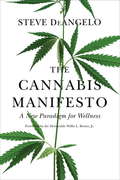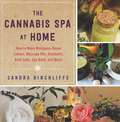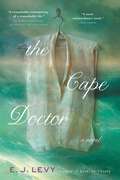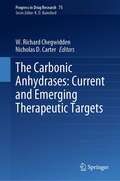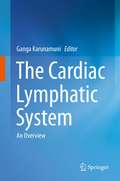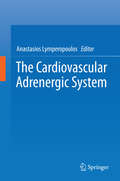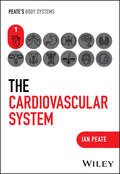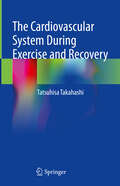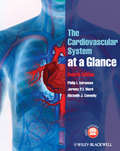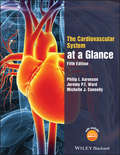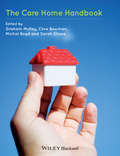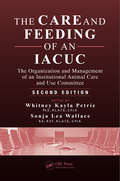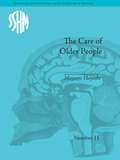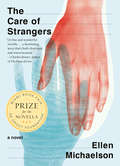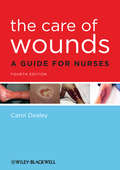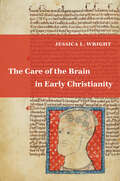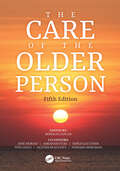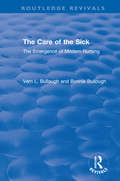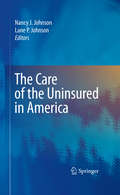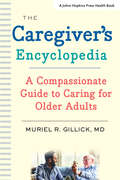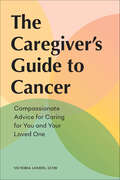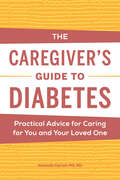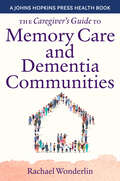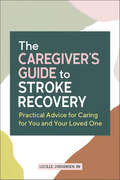- Table View
- List View
The Cannabis Health Index
by Uwe BleschingThis comprehensive sourcebook combines evidence-based insights from more than 1,000 studies from cannabinoid and consciousness research to present a convincing case for the powerful healing effects of medical marijuana on over 100 chronic symptoms and diseases. Written by a former paramedic with a PhD in alternative healthcare, this in-depth reference shows that the subtle shifts in awareness commonly observed in cannabis-using patients vastly contribute to these compounds' therapeutic potential. The Cannabis Health Index is organized into condition-specific chapters, with eye-catching ratings of cannabis efficacy for each symptom, along with recommendations for use, and sidebars that suggest related mindfulness-based practices that enhance the body's own ability to heal. Organized alphabetically from aging to wound care, with sections on a variety of conditions including infections, cancer, cardiovascular health, eye diseases, inflammatory diseases, neurological diseases, and much more, the Index reveals that the huge body of scientific studies focused on cannabis is a tremendously under-utilized repository of knowledge. In synthesizing the findings of these studies, Blesching brings clarity to the process of making informed decisions about cannabis as a valid treatment. Informative, user-friendly, and practical, The Cannabis Health Index presents striking evidence that cannabis is remarkable safe and effective when used within the proper therapeutic window, especially compared with the risks of managing chronic symptoms with pharmaceuticals.
The Cannabis Manifesto: A New Paradigm for Wellness
by Willie L. Brown Steve DeangeloWritten by the founder and CEO of the world's largest medical cannabis dispensary, The Cannabis Manifesto delivers a clear, concise history of cannabis as a medicine, details the unintended consequences of prohibition, and considers its future as a regulated consumer product. Steve DeAngelo draws on his experience serving the sick as the head of the controversial Harborside Health Center and a colorful lifetime of working for social justice to present a compelling call for the legalization of this most controversial of plants. His provocative argument that there is no such thing as recreational cannabis challenges readers to rethink everything they thought they knew about marijuana--and teaches them how to use it responsibly. The Cannabis Manifesto answers essential questions about the plant, employing extensive research to fuel a thoughtful discussion around cannabis science and law while at the same time taking readers on a magical tour of a little-known world. DeAngelo explains how cannabis prohibition has warped our most precious institutions--from the family, to the workplace, to the doctor's office and the courtroom. His vivid narrative provides a lively, behind-the-scenes look at Harborside's showdown with the federal government and details the life of a hippie who missed the sixties. In calling for a realistic national policy on a substance that has been used by half of all Americans, this essential primer will forever change the way the world thinks about cannabis, its benefits, and the laws governing its use.
The Cannabis Spa at Home: How to Make Marijuana-Infused Lotions, Massage Oils, Ointments, Bath Salts, Spa Nosh, and More
by Sandra HinchliffeThe First Book to Bring Together Spa, Cannabis, and Herbal Healing The Cannabis Spa at Home contains more than seventy-five cannabis spa recipes free of preservatives and major allergens that can be prepared in the home kitchen or professional spa with wholesome herbal ingredients. Cannabis spa isn’t new--cannabis has been used for thousands of years for external use in the traditional health practices of Eastern cultures. In locations where cannabis has renewed legal status today, cannabis spa potions such as lotions, salves, poultices, scrubs, and baths are being rediscovered as a healthy alternative for managing pain, soothing irritated skin, and enhancing the spa experience. In The Cannabis Spa at Home, you’ll discover which spa preparations provide local healing--and which have potential for a more euphoric experience. You’ll also learn how to make: Refrigerated and shelf-stable cannabis lotions, creams, balms, and masks Emulsions, cannabis base oils, cannabis herbal poultices, aromatherapy essence water, cannabis bath salts, and foot and hand soaks Edible treats such as luscious spa nosh, hemp smoothies, and cannabis bhang
The Cape Doctor
by E. J. LevyA "gorgeous, thoughtful, heartbreaking" historical novel, The Cape Doctor is the story of one man&’s journey from penniless Irish girl to one of most celebrated and accomplished figures of his time (Lauren Fox, New York Times bestselling author of Send for Me). Beginning in Cork, Ireland, the novel recounts Jonathan Mirandus Perry&’s journey from daughter to son in order to enter medical school and provide for family, but Perry soon embraced the new-found freedom of living life as a man. From brilliant medical student in Edinburgh and London to eligible bachelor and quick-tempered physician in Cape Town, Dr. Perry thrived. When he befriended the aristocratic Cape Governor, the doctor rose to the pinnacle of society, before the two were publicly accused of a homosexual affair that scandalized the colonies and nearly cost them their lives. E. J. Levy&’s enthralling novel, inspired by the life of Dr. James Miranda Barry, brings this captivating character vividly alive.
The Carbonic Anhydrases: Current and Emerging Therapeutic Targets (Progress in Drug Research #75)
by W. Richard Chegwidden Nicholas D. CarterThis volume assembles and integrates the wealth of diverse information that is now accumulating in this burgeoning field. The existing and potential therapeutic applications of targeting CA cover a remarkably wide-range of diseases and disorders and have generated increasing and extensive interest in recent years. Its inter-disciplinary approach embraces both the most up-to-date therapeutic application of CA-targeting and the latest research data that will provide a platform for the development of novel applications. The interested audience comprises scientists and clinicians from many relevant disciplines within science and medicine.
The Cardiac Lymphatic System
by Ganga KarunamuniThe heart is invested with a complex, intertwining network of blood and lymphatic vessels which, respectively, provide the cardiac tissue with oxygen and nutrients and eliminate excess fluid from the interstitium. The coronary blood vessels have been the focus of much investigation in the past few decades. On the other hand, the literature regarding the cardiac lymphatic vessels remains sparse, despite their important role in maintaining normal heart function. With this in mind, a better understanding of the cardiac lymphatic network and its ability to regulate fluid homeostasis within the heart could give us insight into developing therapies for the alleviation of several cardiac pathological conditions.
The Cardiovascular Adrenergic System
by Anastasios LymperopoulosAn overview of all the available literature on the various aspects of the regulation of the cardiovascular system`s function and physiology by the adrenergic neurohormonal system, i. e. the catecholamines norepinephrine and epinephrine. Although there are several books describing the adrenergic system`s biology, physiology and pharmacology, and also several excellent books on cardiovascular physiology and pathology, this book focuses exclusively on the interface of these two areas: cardiovascular regulation by the adrenergic system and how it affects cardiovascular diseases and their treatments. Each chapter describe the roles of the adrenergic system first in each cardiovascular cell type (cell type-by-cell type) and then in specific areas of cardiovascular physiology, such as in exercise and in cardiovascular metabolism. Finally, the book concludes with a chapter on the adrenergic system`s role in the currently very "hot" (in terms of scientific investigations) area of cardiovascular stem cell biology. The book covers the adrenergic system--specifically and exclusively in the heart and vessels. It is formatted by cardiovascular cell type-by-cell type manner, rather than in an organ-by-organ or in a disease-by-disease manner, as usually discussed in standard, conventional biomedical textbooks. The book also discusses the adrenergic system in novel, cutting-edge cardiovascular research areas, in which it has not been covered well so far (e. g. stem cells, exercise). These three areas constitute the most important assets of the book, which sets it apart from others in the field.
The Cardiovascular System (Peate's Body Systems)
by Ian PeatePEATE’S BODY SYSTEMSTHE CARDIOVASCULAR SYSTEM A CONCISE, ILLUSTRATED, AND ACCESSIBLE GUIDE TO THE CARDIOVASCULAR SYSTEM Each of the twelve volumes in Peate’s Body Systems series is rooted in the belief that a deep and thorough understanding of the human body is essential for providing the highest standard of care. Offering clear, accessible and up-to-date information on different body systems, this series bridges the gap between complex scientific concepts and practical, everyday applications in health and care settings. This series makes for an invaluable resource for those committed to understanding the intricacies of human biology, physiology and the various systems that sustain life. The Cardiovascular System is the perfect companion for students and newly registered practitioners across nursing and allied health fields with an interest in cardiovascular care, providing a comprehensive yet easy-to-digest guide for both academic and clinical application. Equips healthcare students and practitioners with the necessary information to provide safe and competent care Features colourful illustrations to aid comprehension, clarify complicated concepts, and render content more engaging and accessible Empowers readers to adapt to a rapidly evolving healthcare landscape, preparing them for the future of healthcare delivery Contains information necessary for effective patient care of those with heart failure, hypertension, and other cardiovascular diseases and conditions
The Cardiovascular System During Exercise and Recovery
by Tatsuhisa TakahashiThis book highlights circulatory dynamics and cardiovascular control during exercise and post-exercise and recovery. Composed of seven chapters, it begins with an introduction to the enhanced recovery of heart rate to its pre-exercise resting level by light exercise, compared with heart rate during complete-rest recovery. The second chapter deals with similar time courses of mean blood pressure during recovery from exercise in an upright and a supine position. The recovery of a slowly decreasing heart rate after exercise is shown in the third chapter and facilitated by cool-down exercise. Chapter four addresses that a biphasic change in heart rate at the onset of light exercise, occurs from rest in upright, but not in a supine posture. The book then highlights postexercise regulation of the cardiovascular system between inactive and active recovery from moderate cycle exercise in an upright and a supine position in the fifth chapter. Chapter six demonstrates the differences in bloodflow velocity in the femoral artery measured by Doppler ultrasound velocimetry between inactive, passive, and active recovery. The book finally presents the Doppler measurement of blood flow velocity in the middle cerebral artery at rest and during cycle exercise and compares measurements between men and women. This publication aims for a broad audience that includes medical students and residents, graduate students in the medical sciences, kinesiology, biomedical engineering, and sports medicine, specialists in aerospace medicine and gravitational physiology, cardiologists, and any physician or medical professional with an interest in human cardiovascular function.
The Cardiovascular System at a Glance
by Jeremy P. Ward Michelle J. Connolly Philip I. AaronsonThis concise and accessible text provides an integrated overview of the cardiovascular system - considering the basic sciences which underpin the system and applying this knowledge to clinical practice and therapeutics. A general introduction to the cardiovascular system is followed by chapters on key topics such as anatomy and histology, blood and body fluids, biochemistry, excitation-contraction coupling, form and function, integration and regulation, pathology and therapeutics, clinical examination and investigation - all supported by clinical cases for self-assessment. Highly visual colour illustrations complement the text and consolidate learning.The Cardiovascular System at a Glance is the perfect introduction and revision aid to understanding the heart and circulation and now also features:An additional chapter on pulmonary hypertensionEven more simplified illustrations to aid easier understandingReorganized and revised chapters for greater clarityBrand new and updated clinical case studies illustrating clinical relevance and for self-assessmentThe fourth edition of The Cardiovascular System at a Glance is an ideal resource for medical students, whilst students of other health professions and specialist cardiology nurses will also find it invaluable. Examination candidates who need an authoritative, concise, and clinically relevant guide to the cardiovascular system will find it extremely useful.A companion website featuring cases from this and previous editions, along with additional summary revision aids, is available at www.ataglanceseries.com/cardiovascular.
The Cardiovascular System at a Glance (At a Glance)
by Jeremy P. Ward Michelle J. Connolly Philip I. AaronsonEverything you need to know about the cardiovascular system... at a Glance! The Cardiovascular System at a Glance is the essential reference guide to understanding all things circulatory. Concise, accessible, and highly illustrated, this latest edition presents an integrated overview of the subject, from the basics through to application. Featuring brand new content on stroke, examination and imaging, heart block and ECGs, and myopathies and channelopathies, The Cardiovascular System at a Glance goes one step further and offers new and updated clinical case studies and multiple-choice questions on a supplementary website. Integrates basic science and clinical topics Offers bite-size chapters that make topics easy to digest Includes coverage of anatomy and histology, blood and haemostasis, cellular physiology, form and function, regulation and integration of cardiovascular function, history, examination and investigations, pathology and therapeutics Filled with highly visual, colour illustrations that enhance the text and help reinforce learning The fifth edition of The Cardiovascular System at a Glance is an ideal resource for medical students, junior doctors, students of other health professions, and specialist cardiology nurses.
The Care Home Handbook
by Graham Mulley Clive Bowman Sarah Stowe Michal Boyd"I would recommend each Home purchase a copy"- Ian Turner, Chair, Registered Nursing Home Association"Identifies a gap in the sector and offers a practical means of addressing the need."- Des Kelly, OBE, Executive Director, National Care ForumThe Care Home Handbook has one aim: to improve the care and wellbeing of residents in care homes. It informs, reminds and refreshes the reader's knowledge, enabling care homes to meet the essential standards of care required of them.Aimed at all nurses and healthcare assistants working in care homes, this invaluable, unique and jargon-free resource will help staff deliver skilful care, prevent poor practice, and build knowledge and confidence when working with older people. Grounded in everyday practice, this handbook promotes professional and person-centred care that is safe, high-quality, caring and compassionate. It features sections on the resident's journey, values and standards, core nursing skills, common clinical conditions, medicines management, infection control, and risk.
The Care and Feeding of an IACUC: The Organization and Management of an Institutional Animal Care and Use Committee, Second Edition
by Whitney Kayla Petrie Sonja Lea WallaceMaintaining its user-friendly approach, this new edition of a bestseller summarizes information necessary for the effective and efficient operation of an IACUC. The book covers training programs and discusses professional certifications for IACUC administrative and animal care staff. It provides pointers to principal investigators, discusses interactions between IACUCs and other compliance panels, and addresses occupational health and safety programs and the role they play in the overall animal care and use program. It also delves deeply into bioethics to explore how IACUCs can ensure that each proposal to use animals in research includes an ethical review.
The Care of Older People: England and Japan, A Comparative Study (Studies for the Society for the Social History of Medicine #11)
by Mayumi HayashiAcross the globe, populations are getting older. Hayashi surveys the development of residential care in Britain and Japan from the 1920s onwards, using regional case studies, and taking into account the influence of traditions and cultural norms.
The Care of Strangers
by Ellen MichaelsonWinner of the 2019 Miami Book Fair/de Groot Prize, The Care of Strangers is a moving story about friendship set in a gritty Brooklyn hospital, where a young woman learns to take charge of her life by taking care of others.Working as an orderly in a gritty Brooklyn public hospital, Sima is often reminded by her superiors that she's the least important person there. An immigrant who, with her mother, escaped vicious anti-Semitism in Poland, she spends her shifts transporting patients, observing the doctors and residents ... and quietly nurturing her aspirations to become a doctor herself by going to night school. Now just one credit short of graduating, she finds herself faltering in the face of pressure from her mother not to overreach, and to settle for the life she has now.Everything changes when Sima encounters Mindy Kahn, an intern doctor struggling through her residency. Sensing a fellow outsider in need of support, Sima bonds with Mindy over their patients, and learns the power of truly letting yourself care for another person, helping to give her the courage to face her past, and take control of her future. A moving story about vulnerability and friendship, The Care of Strangers is the story of one woman's discovery that sometimes interactions with strangers are the best way to find yourself.
The Care of Wounds
by Carol DealeyThe Care of Wounds addresses all aspects of holistic wound management. The fourth edition of this successful clinical text continues to reflect current research and evidence-based practice, while incorporating the considerable developments which have occurred in wound care practice since the previous edition. It includes chapters on the physiology of wound healing, general principles of wound management, wound management products, and the management of patients with both acute and chronic wounds. The title is an essential read for all nurses and healthcare professionals working in the field of tissue viability and wound healing.Comprehensive and clinically-orientedExamines best practice in wound managementIncorporates national and international clinical guidelines where applicableSuperbly illustrated with full colour throughout
The Care of the Brain in Early Christianity
by Jessica L. WrightCerebral subjectivity—the identification of the individual self with the brain—is a belief that has become firmly entrenched in modern science and popular culture. In The Care of the Brain in Early Christianity, Jessica Wright traces its roots to tensions within early Christianity over the brain’s role in self-governance and its inherent vulnerability. Examining how early Christians appropriated medical ideas, Wright tracks how they used these ideas for teaching ascetic practices, developing therapeutics for the soul, and finding a path to salvation. Bringing a medical lens to religious discourse, this text demonstrates that rather than rejecting medical traditions, early Christianity developed by creatively integrating them.
The Care of the Older Person
by Serge Gauthier Ronald Caplan Abraham Fuks José A. Morais Phil Gold Olivier Beauchet Howard BergmanThe fifth edition of this widely used book by caregivers brings to you updated and revised content, built on the basic understanding that medicine does not work in a vacuum, but rather alongside other disciplines to provide the environment for a healthy and fulfilling long life. Edited by alumni and senior faculty at McGill University, with international contributions, this book advocates the achievement of better, longer, satisfying, and more productive lives for older persons. It is a helpful resource for physicians, professional caregivers, therapists, students, and residents in medical and nursing disciplines, who care for our burgeoning older population and need to know what to look for and when to consult specialists.Key Features:1. Follows a uniform structure with many chapters having a hypothetical vignette for instructional purposes and with the clinical chapters detailing the features and diagnosis of given conditions, along with possible management protocols specific to afflicted older individuals.2. Builds on the success of the previous four editions to provide high-quality content from international experts for physicians and other caregivers in the field.3. Provides possible management for pressing problems, including the nursing home challenge, pandemics such as COVID, and precision therapy for cancer.
The Care of the Sick: The Emergence of Modern Nursing
by Vern L. Bullough Bonnie BulloughOriginally published in 1979, The Care of the Sick is a detailed and comprehensive exploration of the emergence of modern nursing. Beginning with primitive and early historical nursing, the book traces the development of nursing through the ages and covers a variety of key topics, including the rise of the trained nurse; the problems faced by nursing during its development as a profession; education and working conditions; the government and nursing; the economics of nursing; and how the image of nursing has changed over time. Extensive and thorough, The Care of the Sick will appeal to those with an interest in the history of nursing, the history of medicine, and social history.
The Care of the Uninsured in America
by Lane P. Johnson Nancy J. JohnsonThey earn too much for Medicaid but not enough to afford a health plan. Or their employer rescinded their benefits. Or they're "not disabled enough" for disability. Some 45 million people have fallen through the cracks of America's health care system, and this lack of coverage affects access to coverage, timeliness of care--even life expectancy. The Care of the Uninsured in America presents a nuanced portrait of this broad population--urban and rural, from generational poverty and the working poor--while illuminating the current state of medical/dental insurance and the circumstances that cause so many to do without. Its authors conceptualize lack of insurance as a health disparity (as are ethnicity, gender, age, etc.), and explain its collective health impact and major issues involved in providing care. In clear, useful prose, the book: Identifies subpopulations among the uninsured (e.g., the mentally ill, the homeless, people with HIV) and their specific care needs. Outlines necessary skills and strategies for working with uninsured patients, from health promotion to cultural competency. Offers models and case examples of innovative care programs. Reports on methods for improving access and support, including coalition building and health information management. Describes medication assistance programs: how they work and what they cost. Discusses chronic care and disease management among the uninsured. Analyzes the universal health care debate and makes recommendations. The Care of the Uninsured in America will attract a wide audience among professionals and graduate students in public and community health and health policy; clinicians and nurses who treat the uninsured; administrators and managers seeking a deeper understanding of the system; and policymakers and analysts seeking avenues for change.
The Caregiver's Encyclopedia: A Compassionate Guide to Caring for Older Adults (A Johns Hopkins Press Health Book)
by Muriel R. GillickAn indispensable, comprehensive reference for family caregivers.Caregivers hold the key to the health, well-being, and happiness of their aging relatives, partners, or friends. The Caregiver's Encyclopedia provides you with all of the information you need to take the best care of your loved one—from making major medical decisions to making sure you don't burn out. Written by Muriel R. Gillick, MD, a geriatrician with more than 30 years' experience caring for older people, this book highlights the importance of understanding your friend's or family member's overall health. With compassion and expertise, this book will help you "think like a doctor." The content • helps you navigate the health-care system• shares important information about treating basic geriatric syndromes, including delirium, dementia, and falls• teaches you about preventive care options• enables you to manage medical decisions related to both acute and chronic conditions • discusses what Medicare covers—and what it doesn't• guides you through different approaches to care• weighs the risks and benefits of hospital vs. home, nursing home, or hospice care• provides a detailed list of medical supplies that you might want to keep on hand• offers you additional resources and emotional supportThroughout, Gillick provides helpful information and concrete concepts that caregivers can put into practice today. Authoritative, comprehensive, holistic, and highly illustrated, The Caregiver's Encyclopedia will help you figure out how to be the best caregiver you can be.
The Caregiver's Guide to Cancer: Compassionate Advice for Caring for You and Your Loved One (Caregiver's Guides)
by Victoria LandesCare for a loved one with cancer while caring for yourselfLooking after someone with cancer can be complex, overwhelming, and emotionally draining all at once. As a caregiver, you may also overlook your own well-being while you focus on your loved one. This book empowers you to be an attentive, thoughtful, and compassionate caregiver for your friend or family member with cancer. You'll also find practical everyday advice for meeting your own physical and emotional needs while dealing with the unique challenges you face.Understanding cancer—Learn how cancer affects the body at every stage, determine the steps that come after diagnosis, and examine cancer treatments and side effects.Knowledge caregivers need—Find info on navigating health care, financial and legal decisions, and much more.What to say and ask—Find questions to ask your loved one's care team and health providers, and discover how to be an advocate in different situations.Support your loved one while also practicing self-care with the help of this compassionate choice in caregiving and cancer books.
The Caregiver's Guide to Diabetes: Practical Advice for Caring for You and Your Loved One (Caregiver's Guides)
by Amanda CiprichCare for yourself while caring for a loved one with diabetes Taking care of someone with diabetes can be tiring and emotionally draining at times. As a caregiver, you may overlook your own health and well-being because you're so focused on your loved one. This book helps empower you to be an attentive caregiver for your friend or family member with diabetes—while also taking good care of yourself. Give your loved one the support they need with guidance for everything from medications and treatments to financial and legal decisions. You'll also find practical advice for meeting your own physical and emotional needs, and dealing with the unique challenges you face as a caregiver. Understanding diabetes—Learn what diabetes is and isn't, how the condition affects the body, and how your role as caregiver fits in. Relatable stories—Read examples of real situations you might encounter as a diabetes caregiver. What to do, say, and ask—Explore questions to ask your healthcare provider, and get suggestions for what to do and say in specific situations, like if your loved one is having trouble managing their blood sugar or medication side effects. Attend to your own needs while being a supportive diabetes caregiver with help from this compassionate guide.
The Caregiver's Guide to Memory Care and Dementia Communities (A Johns Hopkins Press Health Book)
by Rachael WonderlinThis practical guide provides general caregiving tips and helps you decide when and how to transition your loved one to a dementia care community.Caring for someone with dementia is challenging, especially when it comes time to think about other living arrangements. What do you need to know about dementia, including its different stages? What do you do if the person you're caring for seems to have trouble recognizing you? When is it time to move a person living with dementia into a senior living community? And how can you maintain your relationship with your loved one when you are living apart?Gerontologist and dementia care consultant Rachael Wonderlin has written a compassionate book to help friends and family members of those living with dementia answer these tough questions—and more. In practical, down-to-earth language, The Caregiver's Guide to Memory Care and Dementia Communities walks the reader through key points about dementia care, including • common terminology used by health care workers• strategies for taking care of your loved one• advice for when and how to transition to a dementia care community• understanding how dementia care communities are structured and what to keep in mind when evaluating them• how to help your loved one receive the best possible care while they're living apart• recommendations for handling obstacles involving communication and behavioral issues • information on technology, hospice care, programming and activities, and at-home safetyA dedicated section called "Putting It into Practice" in each chapter helps you apply the principles to your own experience, while worksheets present you with questions to consider as part of the caregiving and assessment process.
The Caregiver's Guide to Stroke Recovery: Practical Advice for Caring for You and Your Loved One (Caregiver's Guides)
by Lucille JorgensenLearn how to care for a loved one after a stroke, and care for yourself, tooA stroke changes the life of more than just the survivor. Becoming a caregiver for a stroke patient means increased responsibilities, hard decisions, and new emotional stresses—especially when the patient is a loved one. This stroke recovery book will help you through these challenging times with knowledge, compassionate guidance, and reaffirming stroke rehabilitation anecdotes. Topics such as medications and treatments, financial and legal decisions, and work-life balance are also covered, as well as:Understanding stroke—Discover the signs and symptoms of a stroke, explained in layperson's terms, as well as the steps to prevent a stroke from occurring.Care and recovery—Find helpful advice to restore the best health and function possible and be an advocate for a stroke patient with doctors and their support team.Caring for yourself—Uncover practical tips, guidance, and resources for supporting a caregiver's mental and physical health, which are just as important to patient recovery.Ease the challenges on your shared path to healing through The Caregiver's Guide to Stroke Recovery.

